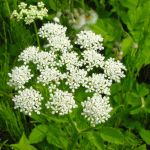
|
| Goutweed |
There are five to seven species of creeping perennials in this genus, found in woodland, scrub, and on waste ground, throughout Europe and temperate Asia. Most species are invasive weeds. The name Aegopodium is derived from the Greek aigos, "goat" and podos, "foot". The epithet podagraria derives from the Latin podagra, "gout", and refers to the plant's medicinal uses. Goutweed was apparently introduced to the British Isles during medieval times, when it was cultivated in monastery gardens for medicinal purposes. It is often referred to as "bishopweed", "bishopwort", or as "herb Gerard" in old herbals because of its ecclesiastical connection and its dedication to St. Gerard, who was invoked to cure gout.
Herbaceous perennial with a creeping rootstock and strong-smelling, long-stalked leaves, 8-23cm (3-9in) long. Tiny which flowers grow in umbels to 6cm (2½in) across in summer.
White-marked leaves and is less invasive. Height: 30-60cm (12-24in) Width: Indefinite |
|